Indiana’s Erie Lackawanna Trail
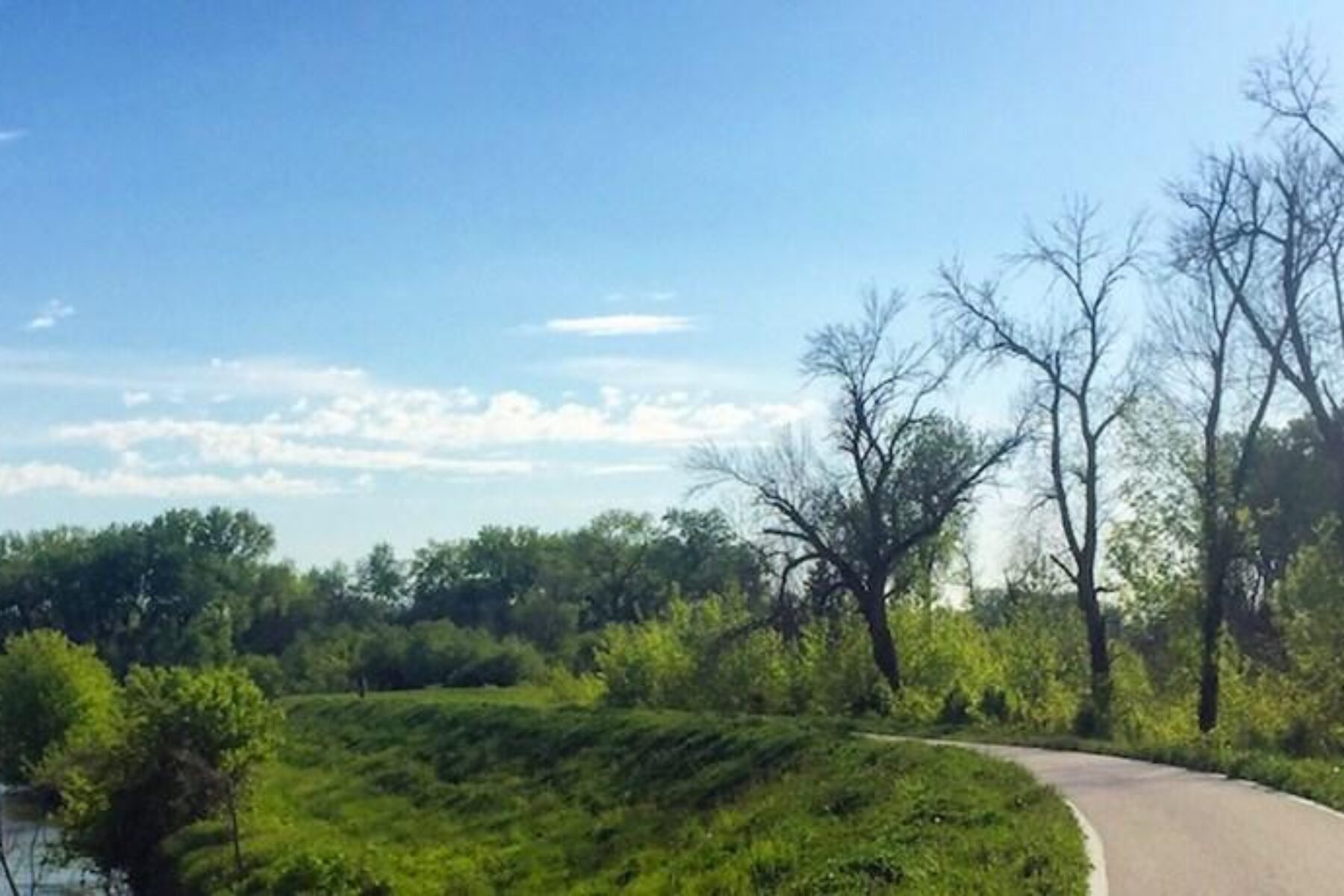
Trail of the Month: March 2018
“From one town to the next, we’re all the same here. We don’t care where one trail ends and another begins.”
—Mark Heintz, administrator for the parks and recreation department of Hammond
Northwest Indiana’s Erie Lackawanna Trail offers an experience of beautiful contrasts. The region boasts sandy dunes, a glimmering Great Lake and windswept prairies, but also has a rich industrial and railroad heritage, some of the largest cities in the state, and the urbanization and cultural vibrancy that comes with its close proximity to Chicago. The diversity and bounty of these surroundings is well matched by the area’s growing system of interconnected multiuse trails that’s allowing near-seamless, people-powered transportation between these natural and manmade assets. The nearly 18-mile Erie Lackawanna Trail alone connects to or is in close range of a half-dozen other trails.
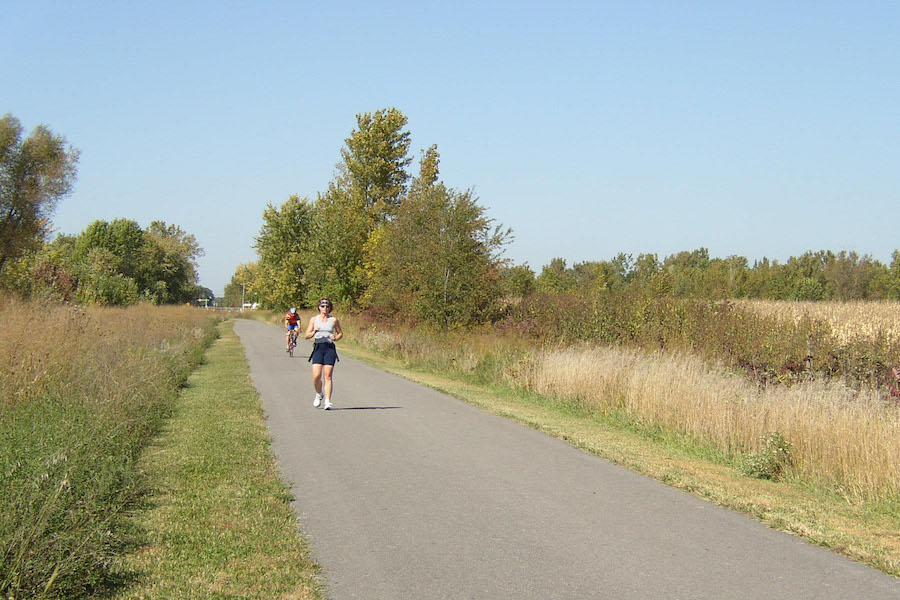
“From our inception, we’re a heavily industrialized area next to Chicago and Gary, which are large steel mill areas,” said Mark Heintz, administrator for the parks and recreation department of Hammond, the city that caps the northern end of the trail. “But in the last 20 years, we’ve made a big push to add recreational value to this corner of northwest Indiana. Millions of people are next door to us, and will come to us for our recreational amenities and go to the destinations that we have.”
The plethora of trails here is not happenstance. During the 19th century, railroad transportation was king in the region as trains carrying people and goods between the powerhouse of Chicago and the East Coast were funneled through Lake County as they skirted around vast Lake Michigan to reach the city. In the modern era, many of these railroad corridors are being reborn as rail-trails, like the Erie Lackawanna Trail.
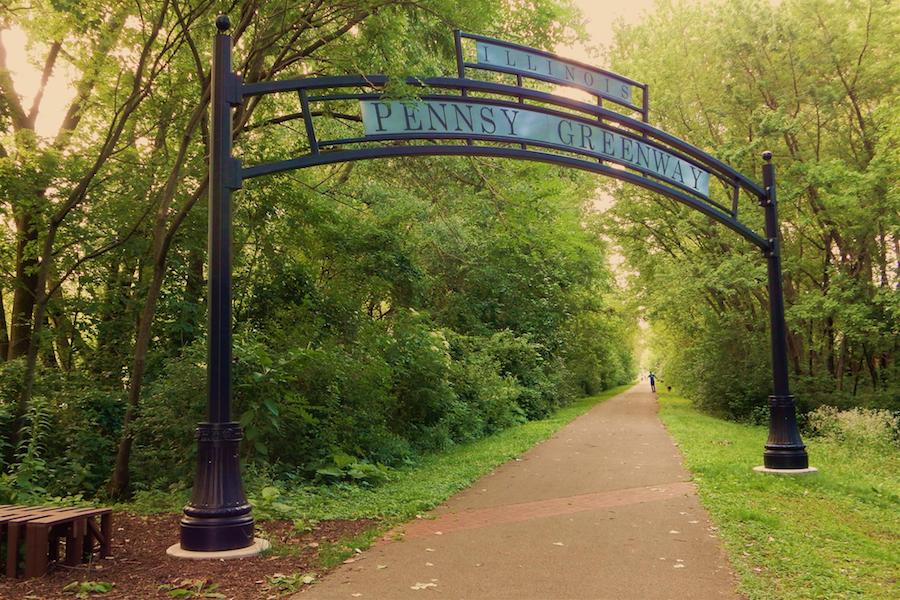
“It’s close to the Pennsy Greenway, which has a cool brick line in the trail, where it crosses into Illinois,” said Eric Oberg, director of trail development for RTC’s Midwest Regional Office, enumerating the latticework of trails around the Erie Lackawanna. “And it connects to the Oak Savannah Trail, which goes east to Hobart, where it almost connects to the Prairie Duneland Trail. The number of miles of trail in this region is compact, and they’re gorgeous, fun trail experiences. They offer unique pockets of landscapes, from prairie remnants to wetlands to very urban and suburban neighborhoods and towns.”
Via these successive connections, one can reach the phenomenal Indiana Dunes National Lakeshore, but there is plenty of scenery and other attractions along the Erie Lackawanna Trail itself that make it an attractive choice to visit. At its southern terminus in Crown Point, a red-roofed picnic shelter—designed to be reminiscent of an old train depot—offers a nod to the trail’s railroad past.
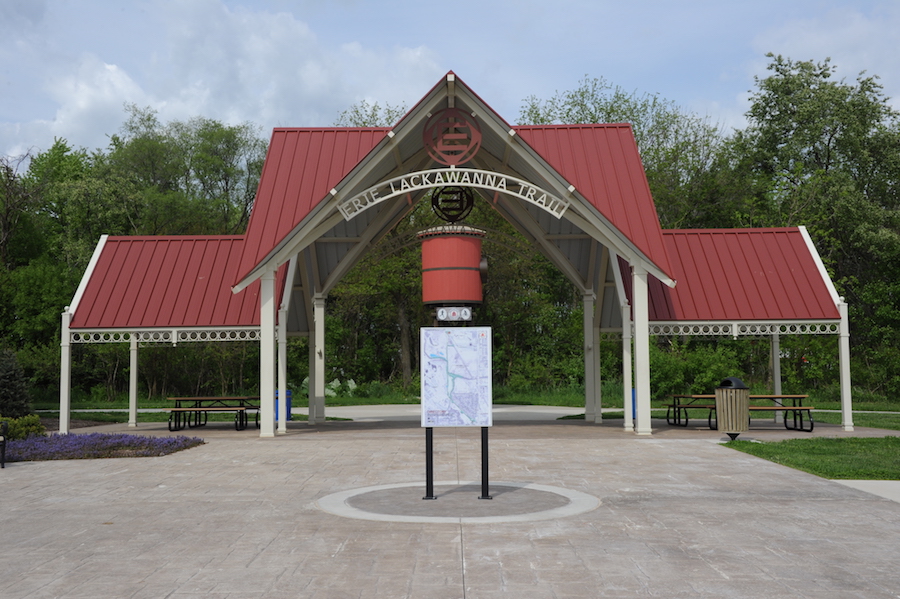
“It’s 20-car parking lot is constantly full,” noted Mitch Barloga, a transportation planning manager for the Northwest Indiana Regional Planning Commission (NIRPC), about the trailhead from which he lives just a couple blocks away. “When I designed it for 20 cars, I thought that was plenty, but the Crown Point trailhead sees more than 200 users a day.”
From Crown Point, the paved pathway has an almost imperceptible downward grade as it heads northwest toward the Lake Michigan shoreline. On its way to Griffith at its midpoint, the trail is verdant in the spring and summer and flush with wildflowers. Cool wooded sections are interspersed with picturesque views of prairie and farmland.
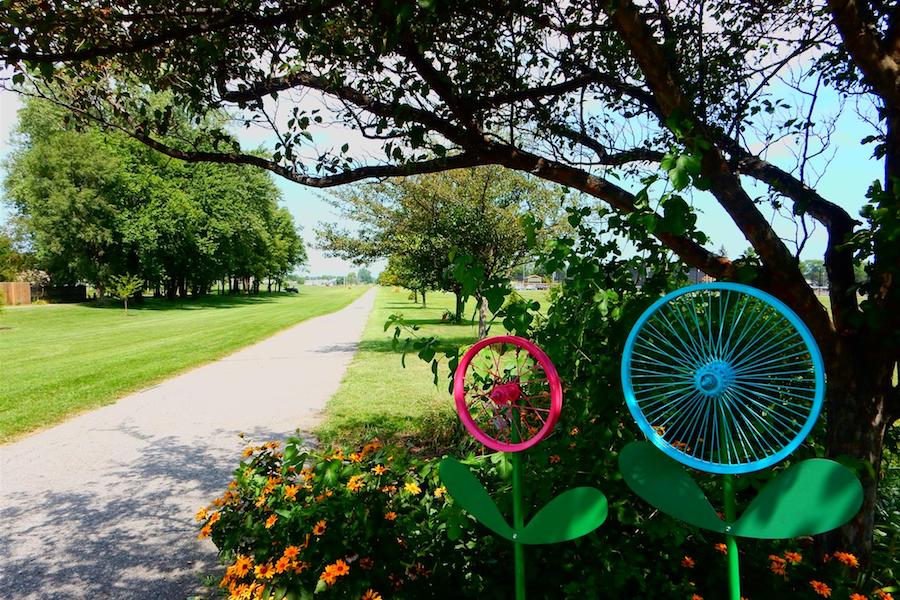
Passing through Schererville, a stone’s throw from Oak Ridge Prairie County Park, trail users may notice that this section of the trail is kept more naturalized by the county to attract wildlife and offer a natural oasis for residents. A trail spur off the Erie Lackawanna spins out along Turkey Creek for just shy of a mile through the breathtaking Ivan Gatlin Nature Preserve—well worth the quick side trip. Observant travelers might see great blue herons, bald eagles, wild turkeys, deer, rabbits and many other types of animals. This section’s charms make it popular, and Craig Zandstra, the superintendent of planning and natural resources for Lake County Parks, notes that the trailhead parking lots here are nearly always full. The trail is now also plowed in winter as people were clamoring to ride or walk it year-round.
“There are one or two subdivisions up against the Erie Lackawanna Trail in that section,” said Zandstra. “Any homes that sell along the corridor, they put up for-sale signs facing the driveway and the trail because a lot of people might want to buy a property that bumps up against the trail. People move to have that access.”
Once in Griffith, history buffs will want to explore the Griffith Historical Society’s railroad museum, housed in a century-old Grand Trunk Depot just off the trail with a caboose, train car and railroad tower out front. The park also overlooks a point where five railroads once crossed each other like a steel star.
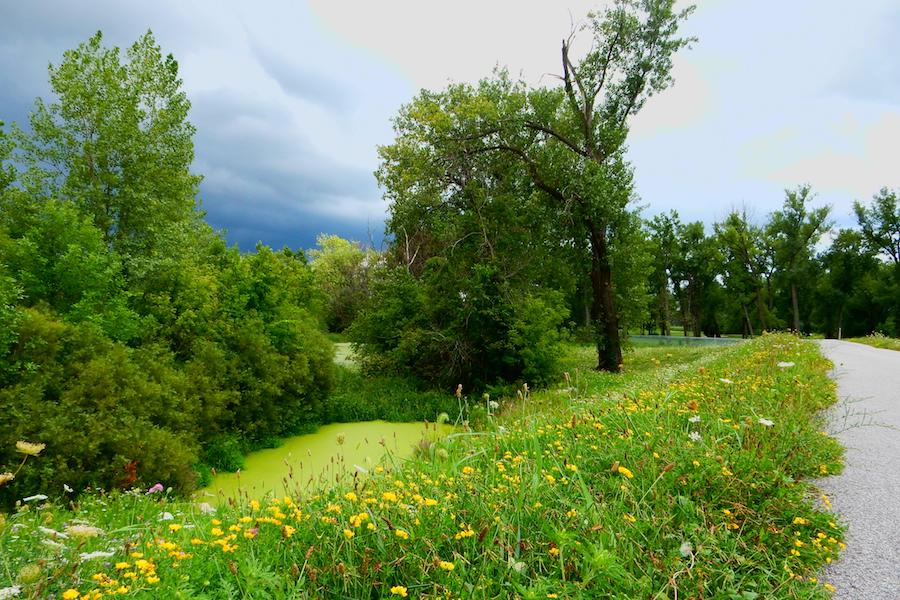
Near its northern terminus in Hammond, the trail forms a triangular loop with another rail-trail, the Monon Trail (not be confused with a trail of the same name in Indianapolis), and the Little Calumet River Levee Trail, for a pleasant ride of about 10 miles. Though the trail is more urbanized at its northern end, it’s buffered by trees.
A huge draw here each summer is the WHAM ride, which stands for Whiting-Hammond After Midnight. Participants can choose a 30-mile or 10-mile route, which incorporates the trail, and end their ride with breakfast in a city park in the wee hours of the morning.
“About 1,000 people join,” said Heintz. “Even though it’s midnight, there are so many people that we have to close down the streets. And it’s for all ages—from 80-year-olds to single-digit kids.”
While it’s easy to see the value of the trail now, the communities of the South Shore region showed great foresight in recognizing its potential in the early 1990s and acting on the project. All along the route, municipalities both small and large, together with Lake County, have embraced the trail and keep their individual sections—some nearly 30 years old—well maintained. And the NIRPC, a regional planning organization, has assisted with unifying the branding of the trail across its length (the trail’s name and logo are borrowed from the Erie Lackawanna Railroad of yore) and with closing the trail’s gaps.
“From one town to the next, we’re all the same here,” said Heintz about this collaborative approach. “We don’t care where one trail ends and another begins.”
Today, the topic of trails is even making its way up to the highest echelons of state government. The Indiana Legislature established the Indiana Bicycle Trails Task Force last year to look at building on and enhancing the existing trail system throughout the state. Nearly two dozen members are on the team, appointed by Governor Eric Holcomb.
“We talk about connectivity and closing the gaps, and we’re looking into funding strategies,” said Barloga, who sits on the task force and is excited by the momentum. “People love these trails.”
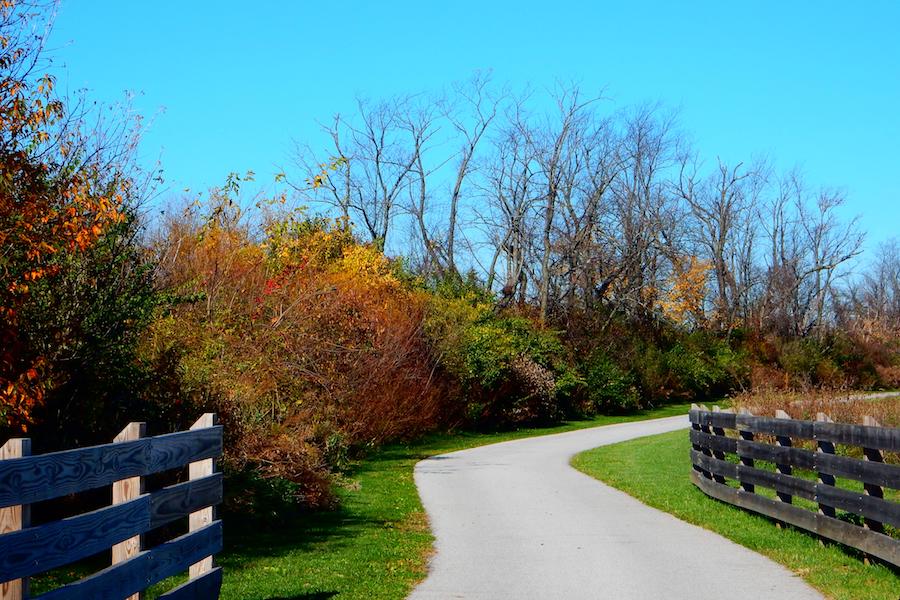
Related Links
Northwest Indiana Regional Planning Commission
Lake County Parks and Recreation
Trail Facts
Name: Erie Lackawanna Trail
Used railroad corridor: Erie Lackawanna Railway
Trail website: Lake County Parks and Recreation
Length: 17.7 miles
County: Lake
Start point/end point: Sibley St. near State St. (Hammond) and W. Summit St. at N. West St. (Crown Point)
Surface type: Asphalt
Grade: The north side of the trail, which is closest to Lake Michigan, has a slightly lower elevation, so traveling the trail from south to north will have a modest downhill grade.
Uses: Walking, biking and inline skating; wheelchair accessible. The trail is plowed in winter for year-round bike/ped use.
Difficulty: Easy, the trail is relatively flat and paved.
Getting there: Chicago Midway International Airport (5700 S. Cicero Ave., Chicago) and O’Hare International Airport (10000 W. O’Hare Ave., Chicago) are the closest major commercial airports, with the Midway located about 20 miles from the trail and O’Hare about 40 miles away.
For those who want to travel by rail, a commuter train called the South Shore Line runs between downtown Chicago and Indiana’s South Bend International Airport (4477 Progress Dr., South Bend), with a stop in Hammond along the way. The South Shore’s Hammond station is located one mile north of the trail at 4531 Hohman Ave. Amtrak’s Hammond-Whiting Station (1135 North Calumet Ave., Hammond) is approximately 6 miles north of the trail’s northern terminus.
Access and parking: To reach the southern trailhead in Crown Point: From I-65, take Exit 249 to E. 109th Ave. toward Crown Point. Head west on E. 109th Ave. and go 0.7 mile. Turn right onto Broadway and go 0.5 mile. Turn left onto E. Summit St. The trailhead is 1.6 miles ahead on the right.
To reach parking at the northern endpoint in Hammond: From I-94, take Exit 71B for IN 83/Sibley Blvd. Head east on Sibley Blvd., and go 3.1 miles, crossing Hohman Ave. Look for parking on the right for the Towle Community Theatre. The trail starts east of the parking lot.
To navigate the area with an interactive GIS map, and to see more photos, user reviews and ratings, plus loads of other trip-planning information, visit TrailLink.com, RTC’s free trail-finder website.
Rentals: Just over the border in Illinois, about 11 miles west of the trail, GoodSpeed Cycles (2125 W. 183rd St., Homewood, IL; 708.957.9888) offers daily and weekly rentals of road bikes, kid’s bikes and bike racks for cars. Chicago also has a plethora of bike shops, so those coming from the city may wish to rent bikes there before heading down to the Erie Lackawanna Trail.

Donate
Everyone deserves access to safe ways to walk, bike, and be active outdoors.
